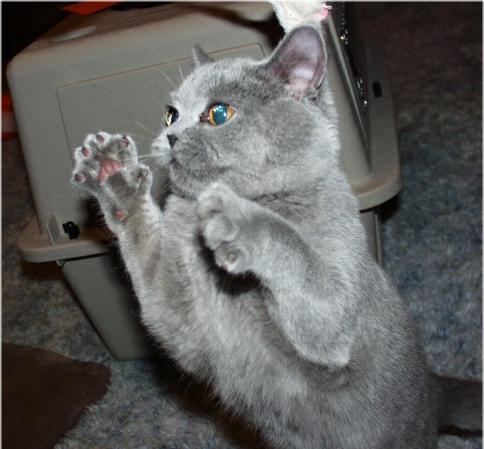
Why Do Cats Scratch?
For cats, scratching is one of their most natural behaviors and it is their way of fulfilling the animalistic need to mark their territory. Not only does the scratching leave visible marks, their paws have secretion glands which will leave a distinct smell for other cats. Also, the scratching motion helps the cat to stretch and exercise their front paws and legs. Cats also like to keep their claws sharp and scratching a vertical object aids in this process.
Some of the reasons cat owners have this procedure done is to prevent their cat from scratching furniture, pulling down draperies, and scratching/fighting with other pets. If there are infants or young children in the house, cat owners feel it is necessary to de-claw their cat just in case the cat playfully scratches their child.
De-clawing a cat's front claws is and has always been a controversial subject. Some people consider it as a form of torture and mutilation. While more than 25 % of cat owners believe de-clawing is OK, because their cat will be an indoor cat and they don't really need their front claws. If you visit your veterinarian, chances are they will discuss some of the alternatives to this elective surgery. In some cases, veterinarians will refuse to perform this surgery, unless it is medically necessary. Personally, I DO NOT believe in this inhumane practice of de-clawing, but you can make up your own mind after reading the facts below.
De-clawing is actually an amputation of the germinal (epithelium) cells, which is responsible for the growth of the claw. It also includes removing all or part of the third phalanx (terminal bone) of the toe. In comparison to the human hand, it is similar to removing the finger tips all the way up to the first knuckle. Your veterinarian will likely use a tourniquet around the toes to reduce blood loss. If the tourniquet is too tight it can damage the radial nerve and may result in temporary and sometimes permanent leg paralysis. If the procedure is not done correctly, the claws may grow back with minor or severe deformity. On occasion, the veterinarian may remove too much of the toe or some/all of the toe pad may inadvertently. Mild or severe infection is another factor to consider. Because the wounds are left open to heal, chances of infection is high. Removing the cats back claws is NEVER recommended. These claws are their only defense if the front claws have been already removed.
The Alternatives:

- Introduce a scratching post to your kitten/cat at a very early age. The scratch post should be tall enough so your kitten/cat can stretch completely out. Make it a fun place for them to play by placing interactive toys around the area. You can also rub catnip all over the post to entice them to use it.
- Discourage unwanted scratching by spraying your kitten/cat with a water spray bottle. You can also distract them with a loud sound such as clapping, a whistle or an air horn.
- Clip your kitten/cat's nails regularly. (weekly or bi-weekly)

- Purchase a set of Soft Paws® nail caps. These are lightweight vinyl caps that you apply over your cat's own claws. They have rounded edges, so your cat's scratching doesn't damage your home and furnishings.
~Deciding whether to de-claw your kitten/cat's front claws is an important decision and it should NEVER be taking lightly. Further more you should NEVER have it done for your own convenience.
~Think about your companion animal first! Above all... Don't De-claw Your Cat's Paw!
Click for more info: De-Clawing.com






No comments:
Post a Comment